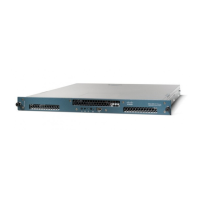Chapter 5 Managing the ACE Software
Capturing and Copying Packet Information
5-32
Cisco 4700 Series Application Control Engine Appliance Administration Guide
OL-11157-01
• circular-buffer—(Optional) Enables the packet capture buffer to overwrite
itself, starting from the beginning, when the buffer is full.
• remove—Clears the packet capture configuration.
• start— Starts the packet capture function. The packet capture function
automatically stops when the buffer is full unless you enable the circular
buffer function.
• stop— Stops the packet capture function.
To enable packet capture on an in
terface VLAN, enter the following:
host1/Admin# access-list acl1 line 10 extended permit ip any any
host1/Admin# capture capture1 interface vlan50 access-list
acl1
host1/Admin# capture capture1 start
To stop the packet capture function on the interface VLAN, enter the following:
host1/Admin# capture capture1 stop
Copying Capture Buffer Information
To copy an existing packet capture buffer to the disk0: file system, use the copy
capture command in Exec mode.
The syntax for the command is:
copy captur
e ca
pture_name disk0: [path/]destination_name
The keywords, arguments, and options are:
• capture_name—Name of the packet capture buffer in Flash memory. Specify
a text string from 1 to 80 alphanumeric characters. If necessary, use the show
capture command to view the files available in Flash memory. This list
includes the name of existing packet capture buffers.
• disk0:—Specifies that the buffer is copied to the disk0: file system. Include
a space between disk0: and a destination path.
•
[path/]destination_name—Destination path (optional) and name for the
packet capture buffer. Specify a text string from 1 to 80 alphanumeric
characters. If you do not provide the optional path, the ACE copies the file to
the root directory on the disk0: file system.

